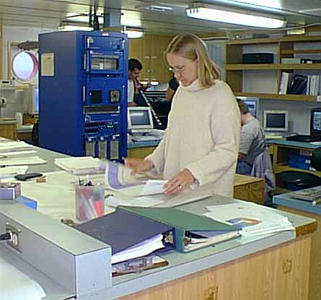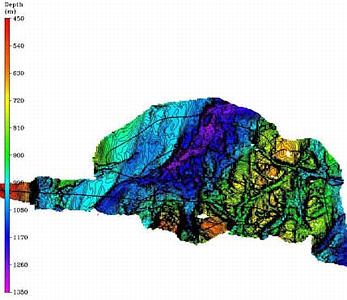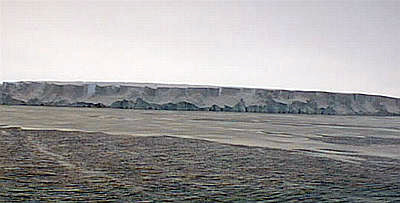8 March, 1999
March 8, 1999
Hello from Antarctica! What a great day we had today! I can't believe how
quickly the shift went by. We started off with a piston core.
Unfortunately, we had a few problems and came up with an empty core three
times in a row. That took over two hours. After that, we started moving
south towards the Thwaites Glacier Tongue. Another name for a glacier
tongue is an ice tongue. It is made when a glacier streams into the sea,
and the floating ice (which is still connected to the land) spreads out
over an area. Glacier tongues are a lot like ice shelves, only narrower.
The Thwaites Glacier Tongue is nearly 20 miles wide and 40 miles long. It
was named after Frederik T. Thwaites, a glacial geologist who was a
professor at the University of Wisconsin. Everyone was running to the
portholes (and outside) to take pictures of the Glacier Tongue. We were
pretty close, and it was really neat!
As we were passing in front of the Thwaites Glacier Tongue, we started a
multibeam survey to map the seafloor in the area. The map that we are
making is really neat. We can see depressions in the sea floor that have
been carved by meltwater from beneath the glacier tongue. The middle area
is the deepest, and we call that area a trough. The map took over five
hours to make, but it was well worth our time. In fact, the day shift
started making the map and the night shift will have to finish it.
Everyone is very excited about how nice it looks and what great information
it gives us. This area is usually full of very close pack ice, so there
aren't very many people who have made it this far into Pine Island Bay. We
are making some of the first detailed maps of this parcticular area. After
the night shift finishes making this map, they will continue east across
the front of the Thwaites Glacier Tongue -- taking more cores and probably
conducting more multibeam surveys.
Julia Smith Wellner is the scientist in charge of the night shift. She is
28 years old, and she is from Sacramento, California. Julia graduated in
1992 from Bryn Mawr College in Bryn Mawr, Pennsylvania, with a B.A. in
Geology. She knew that she probably wanted to major in science, but she
wasn't sure about exactly what area of science. In the fall of her
sophomore year, Julia spent a semester at sea. Upon her return, she
declared her major in Geology. She earned her M.S. from the University of
Alabama in Geology, and is currently working on her Ph.D. at Rice
University in Houston, Texas.
For her research, she has two primary projects. The first one is offshore
Louisiana where she is looking at the last complete cycle of sea level
changes. Here in Antarctica, she is looking for evidence that the East
Antarctic Ice Sheet overrode the Transantarctic Mountains during the last
glacial maximum and grounded in the Pennell Coast area. We gathered data
for Julia's research while we were in Antarctica last year. Julia plans to
graduate in the year 2000 with a degree in Geology and Geophysics. In her
"spare time," she is an active volunteer at Rice and has just taken on the
position of President of the Graduate Student Association. She first met
her husband, Rob Wellner, at the University of Alabama. They have only
been married for 15 months, and he is a geologist who works for Exxon
Production Research.
Did you think about yeterday's question? It was: "What do you suppose
happens to the trash that is produced on this ship?" There are a few
things that are collected and returned to shore for recycling. These
things include batteries, some metal, and glass. Aerosol cans are also
collected and returned to shore. Everything else is incinerated (burned).
There are special screens to remove all of the parcticulates from the
incineration process. The ash and any remaining materials (like unburned
metal) are returned to either McMurdo Station or Lyttelton, New Zealand.
In New Zealand, they are buried in a landfill.
What do you suppose happens to the trash that is produced at McMurdo
Station (or the ship's trash that gets taken there)? In the old days, much
of McMurdo Station's trash was dumped at sea. Thankfully, people realized
that this was a bad way to get rid of garbage! With the temperatures this
cold, decomposition is very, very slow! Today, we are much more aware of
the environment, and no garbage is dumped or stored permanently on the
continent. Every season, a large ship comes down to McMurdo Station
bringing supplies. It is filled up with garbage before it leaves and then
takes the garbage to Seattle, Washington. McMurdo Station is very careful
about sorting materials for recycling, and many of the materials are then
recycled once they get to the U.S.. The rest of the trash is buried in a
landfill back in the continental United States.
Well, that's about all for today. Tomorrow, we'll look at the ship's
galley. Where does Ernest keep all of the food that he purchases? How
often should he restock the food supplies? I'll talk to Ernest and find
out. Until then, I hope things are going great for you. Here in
Antarctica, I'm having a terrific time!
Kim Giesting
Latitude: 74 degrees 10 minutes South
Longitude: 106 degrees 33 minutes West
Temperature: -7.9 degrees C
Barometer: 971.8 mb
Wind Speed: 15.3 knots
Wind Direction: 132 degrees (from the Southeast)
Sunrise:04:49
Sunset: 19:29

Julia Smith Wellner is studying data from the Bathy-2000. The "bathy" is one of our instruments that uses sonar to detect the depth of the sea floor. It also gives us some information about the bottom sediments.

This is the multibeam map that we made. The trough is dark blue and purple. The green areas (to the east of the trough) are the depressions cut by meltwater. This entire map covers an area that is about 13 miles wide.

This is a picture of the Thwaites Glacier Tongue in Pine Island Bay.
Contact the TEA in the field at
.
If you cannot connect through your browser, copy the
TEA's e-mail address in the "To:" line of
your favorite e-mail package.
|
